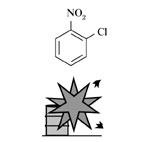| Case Name |
Explosion due to delayed start of agitation at the start-up of reaction of o-nitrochlorobenzene |
| Pictograph |

|
| Date |
July 18, 1973 |
| Place |
Wakayama, Wakayama, Japan |
| Location |
Chemical factory |
| Overview |
An explosion occurred in a plant that manufactured o-nitroanisole from o-nitrochlorobenzene. First, methanol and sodium hydroxide were put into the reactor and agitated. Agitation stopped because the motor of the agitator was faulty. The motor was changed. As o-nitrochlorobenzene had been charged before agitation restarted, raw materials separated into two layers. When agitation restarted, the materials that had been separated into two layers were rapidly mixed. Therefore, a rapid reaction occurred, temperature and pressure rose rapidly, and the contents spouted out from the safety valve and the manhole. As a result, the contents ignited and exploded. |
| Incident |
At a plant where o-nitroanisole was manufactured from nitrochlorobenzene, contents in the reactor spouted out from a safety valve and a manhole in the reactor, ignited and exploded. For reference, the main reaction formula of the plant is shown at Fig2. |
| Processing |
Manufacture |
| Individual Process |
Charge and Feed |
| Process Flow |
Fig3.Unit process flow
|
| Chemical Reaction |
Other |
| Chemical Equation |
Fig2.Chemical reaction formula
|
| Substance |
Sodium hydroxide, Fig4 |
| Methanol, Fig5 |
| o-chloronitrobenzene, Fig6 |
| Type of Accident |
Leakage, explosion, health hazard |
| Sequence |
On July 18th, 1973, 01:00: The reactor was rinsed with water, and charging of methanol started.
02:00: Charging sodium hydroxide into the reactor started.
02:15: Agitation of the reactor started, and simultaneously cooling began.
06:00: The agitator stopped, and cooling water supply stopped. As the agitator motor was faulty, work to replace the motor started.
07:30: Disconnection of the motor was completed.
08:00: The work shift was changed.
08:40-50: O-nitrochlorobenzene was charged into the reactor.
09:30-10:00: The agitator motor was mounted.
10:00: The agitation restarted
10:20: Steam began to be supplied.
10:40: Steam was stopped because the solution temperature rose to 50°C. However, the temperature continued to rise.
11:00: Cooling began as the temperature had risen to 60 °C. However, the temperature rose to 80 °C, and pressure increased, too. So, pressure was released, but it was not effective.
11:05: The contents spouted, and an explosion and a fire occurred. The safety valve operated. In addition, yellow liquid spouted up about 3 m from the manhole. Flames of about 5 m spouted with an explosive sound when the operators began to go down stairs to evacuate. |
| Cause |
When o-nitrochlorobenzene was charged, raw materials had separated into two phases because the agitator had not been working. Under this condition, agitation started, and a rapid reaction occurred naturally, pressure and temperature rapidly rose, and the reaction could not be controlled. |
| Response |
As the temperature rise had continued, the heating steam was stopped and the cooling operation was carried out. However, the runaway reaction could not be stopped. |
| Countermeasures |
1. An operation standard assuming problems in facilities and equipment should be prepared.
2. Education and training on reaction danger and emergency countermeasures should be given to workers.
3. Improvements in the plant should be carried out as follows.
Mounting of an interlock to prevent nitobenzene from being charged when the agitator stopped.
Installation of the cooling system in the reactor to cool down to a low temperature at which a reaction does not occur by even rapid restarting of agitation, in preparation for an emergency stop.
Installation of the large blow-down vessel that can dilute the reactor liquid to a safe concentration. |
| Knowledge Comment |
1. Accidents caused due to restarting agitation after stopping of an agitator occur frequently. A similar phenomenon happens when agitation is delayed during a start-up operation. A system that does not cause a delay in the beginning of agitation might be necessary.
2. The operation standard is made on the assumption of abnormal situations and equipment and facility problems. |
| Background |
When the motor failed, the operators did not follow the operation standard because they did not fully understand the danger involved in the reaction, or because of an inadequate operation standard. Safety education on the reaction seemed to be insufficient.
The safety countermeasures of the facilities were not sufficient, for example, there was no starting interlock to prevent the charging of nitrochlorobenzene after agitation stopping. |
| Reason for Adding to DB |
Example of accident caused due to insufficient consideration of emergency cases in operation standards, education, and training |
| Scenario |
| Primary Scenario
|
Poor Value Perception, Poor Safety Awareness, Insufficient Safety Measure, Insufficient Analysis or Research, Insufficient Practice, Lack of Imagination, Other Reaction, Malicious Act, Rule Violation, Safety Rule Violation, Planning and Design, Poor Planning, Poor Design, Bad Event, Chemical Phenomenon, Abnormal Reaction, Secondary Damage, External Damage, Explosion, Bodily Harm, Injury, 69 person injured, Bodily Harm, Sickness, Near-by Inhibitant Damaged
|
|
| Sources |
Masamitsu Tamura, Masahide Wakakura, o-nitrochlorobenzene explosion, Reaction danger - Accident case and analysis - p.130(1995).
|
| Number of Injuries |
69 |
| Physical Damage |
The surface of the wall of a three-storied factory with the steel frame burned. The reactor was damaged. |
| Consequences |
Mist of nitrochlorobenzene and methanol dispersed in a residential area. The residents and children complained of sore eyes and throats, and were treated in hospital. |
| Multimedia Files |
Fig4.Chemical formula
|
|
Fig5.Chemical formula
|
|
Fig6.Chemical formula
|
| Field |
Chemicals and Plants
|
| Author |
OGAWA, Terushige (Graduate School of Environment and Information Sciences, Yokohama National University)
TAMURA, Masamitsu (Center for Risk Management and Safety Sciences, Yokohama National University)
|
|